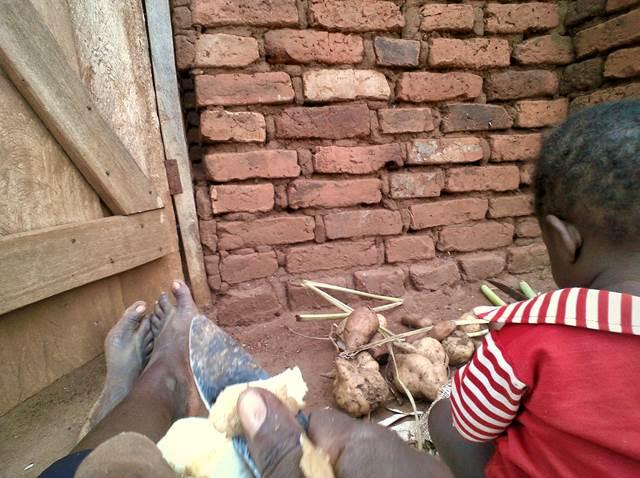Accurately assessing how women spend their time is a critical step towards achieving several Sustainable Development Goals (SDGs), most especially concerning gender equality (SDG 5) and the burden of unpaid work (target 5.4). Due to women's ubiquitous role as primary caregivers, understanding women's time use is also crucial to designing effective policies and programmes to improve child nutrition (SDG 2), health and well-being (SDG 3).

Photo: Mother peeling sweet potatoes while providing passive care for her child, Eastern Uganda, photo from a wearable camera, INATU study.
Most of what we know about time use around the world derives from large-scale government-sponsored social and economic surveys. For over a century, surveys in high-income countries have typically utilized the time diary method; equivalent surveys in low-income countries (LICs) (starting in the 1990s) have typically utilized the 24-hour recall (24HR) method. Traditionally, these surveys assessed only work done in the formal market, whereas women, especially in rural LICs, tend to work in the informal market. A study using methods that account for informal work suggests that traditional surveys may underestimate women's work by half.
Preliminary results from the project Using Information Communication Technologies (ICTs) to understand the relationships between labour-saving agricultural innovations, women’s time use and maternal and child nutrition outcomes (running title: "ICTs for Nutrition, Agriculture, and Time Use" (INATU) study) underscore this and other limitations of traditional methods of measuring women's time. INATU, carried out in January and February 2018 in Eastern Region, Uganda, aimed to validate the use of wearable cameras for assessing women's time use in a rural, LIC. Images automatically captured every 30 seconds by a small camera worn on each woman's shirt were used the following day in an image-assisted recall. The method generates about 1,500 first-person photos per woman-day, that can be later reviewed and analyzed side-by-side with the respondent's narration of her activities. Using data from the INATU study, we can explore in greater detail than previously possible the ways in which women's work time gets discounted.

Photo: Mother cutting fruit, Eastern Uganda, photo from a wearable camera, INATU study.
Overlapping activities and task-switching - The chief characteristic of work commonly performed by women in rural LICs–variously described as "simultaneous", "overlapping", "multi-tasking", or "frequent task switching"–is poorly captured by traditional time use assessment methods. In studies requiring identification of just a single "primary" activity per timeslot, commonly the case in large-scale time use studies, "secondary" activities often go unreported by respondents. The amount of time "lost" by traditional methods is rarely quantified empirically, however using secondary data, it has been estimated that 3-4 hours of childcare are performed as a secondary activity for every hour of childcare recorded as a primary activity.
Combined production for home use and market - In the International Classification of Activities for Time-Use Statistics (ICATUS-2016), production activities are coded differently depending on whether they are for sale or for home use. In reality, women do not divide their efforts in this fashion. Rather, production for home use and market are tightly interwoven. In the INATU study, we see women collecting food from the garden, peeling cassava, sorting beans, weaving mats, and producing charcoal and bricks. For all of these goods, some portion is used immediately in the home, some is stored for later use, and some is sold. Women are "simultaneously" engaged in employment and home production. For traditional studies, which activity–employment or home production–would be listed as the single "primary" activity?
Home-based shop "keeping" - Another problematic type of work we see in the INATU study is a home-based shop. Women "open" the shop at the start of the day and "close" the shop at the end of the day. In between, women carry-out home-based chores–cooking, cleaning, childcare–pausing briefly to handle customers when they come. In a small rural town, the customers are not many–maybe five in a day–but the women are nonetheless still "keeping" the shop all day. Are these women working as shopkeepers all day, or only in the brief periods in which they are directly handling customers?
Extended timeline of common tasks - Similar to shopkeeping, many so-called "reproductive" tasks are characterized by short periods of direct activity interspersed with long periods of waiting. Cooking is a salient example. In the INATU study, women cooked with a traditional charcoal stove. Cooking common foods, such as sweet potato, cassava, rice, and beans, can require hours. Is the woman only cooking during the brief periods where she's directly engaging the fire, ingredients, cooking vessel or stirring implement, or is she still cooking (as the beans simmer on the stove) while also washing clothes?
Passive caregiving - Images collected via wearable cameras in the INATU study also make evident the large proportion of time that women spend providing "passive" childcare. What this looks like–from a first-person camera perspective– is a large bucket of dirty laundry getting washed, or a large pile of sweet potatoes getting peeled, or pot of food getting cooked, etc. while a small child plays alone or with other children a few feet away. ICATUS-2016 explicitly accounts for direct childcare (caring for children including feeding, cleaning and providing physical care, talking with and reading to children, etc.), and also "minding children (passive care)". Explicitly accounting for passive childcare is important in the conceptional framework linking women's time to child wellbeing. However, it's not at all clear that women themselves are sufficiently cognizant of their time spent providing "passive childcare" to report it either in time diaries or 24HR. Preliminary INATU results suggest that women's time spent caregiving was underreported by nearly 65% (from a median 488 minutes per day to just 167 minutes per day) using the 24HR method compared to direct observation. Importantly, it appears that "passive childcare" often goes unrecorded by observers too.
It is critical to consider not just how an outside observer would characterize women's time but also, given that traditional methods rely on self-reporting, how a woman herself would characterize her time. Despite recent progress, further research and development is needed to quantify how much time allocated to caregiving is "lost" using traditional methods and to improve them to more fully account for women's work. Time use diaries and 24HR are unlikely to be replaced anytime soon, but wearable cameras can provide much-needed evidence of previously "invisible" tasks.
Click here to learn more about the ICTs project funded through an IMMANA Grant.
Other research in and outside of IMMANA focused on time use:
- IMMANA Grant project on His and Hers, time and income: How intra-household dynamics impact nutrition in agricultural households
- IMMANA Grant project on New Keys for Old Black Boxes: Developing Methods to Improve Nutrition Assessment by Measuring Energy Expenditure
-
Sara Stevano, Suneetha Kadiyala, Deborah Johnston, Hazel Malapit, Elizabeth Hull & Sofia Kalamatianou (2019) Time-Use Analytics: An Improved Way of Understanding Gendered Agriculture-Nutrition Pathways, Feminist Economics, 25:3, 1-22, DOI: 10.1080/13545701.2018.1542155
-
Deborah Johnston, Sara Stevano, Hazel J. Malapit, Elizabeth Hull, Suneetha Kadiyala (2018) Review: Time Use as an Explanation for the Agri-Nutrition Disconnect: Evidence from Rural Areas in Low and Middle-Income Countries, Food Policy, 76, 8-18, DOI: 10.1016/j.foodpol.2017.12.011
References
Buvinic, M., & King, E. M. (2018). Invisible No More? A Methodology and Policy Review of How Time Use Surveys Measure Unpaid Work. Data2X.
Engle, P. L., Menon, P., & Haddad, L. (1997). Care and Nutrition: Concepts and Measurement. Washington, D.C.
Floro, Maria S., & King, E. M. (2016). The present and future of time-use analysis in developing countries. Asia-Pacific Population Journal, 31(1), 5–42. https://doi.org/10.18356/748e616d-en
Floro, Maria Sagrario. (1995). Economic restructuring, gender and the allocation of time. World Development, 23(11), 1913–1929. https://doi.org/10.1016/0305-750X(95)00092-Q
Hawkes, K., O’Connell, J. F., & Blurton Jones, N. G. (1997). Hadza Women’s Time Allocation, Offspring Provisioning, and the Evolution of Long Postmenopausal Life Spans. Current Anthropology, 38(4), 551–577. https://doi.org/10.1086/204646
Hirway, I., & Jose, S. (2011). Understanding Women’s Work Using Time-Use Statistics: The Case of India. Feminist Economics, 17(4), 67–92. https://doi.org/10.1080/13545701.2011.622289
Ilahi, N. (2000). The Intra-household Allocation of Time and Tasks: What Have We Learnt from the Empirical Literature? In Policy Research Report on Gender and Development Working Paper. The World Bank.
Mattingly, M. J., & Blanchi, S. M. (2003). Gender Differences in the Quantity and Quality of Free Time: The U.S. Experience. Social Forces, 81(3), 999–1030. https://doi.org/10.1353/sof.2003.0036
Nti, C. A., Inkumsah, D., & Fleischer, G. (1999). Influence of women’s workload on their nutritional status in selected communities in Ghana. Journal of Consumer Studies & Home Economics, 23(3), 165–170. https://doi.org/10.1046/j.1365-2737.1999.00106.x
Peterman, A., Ng, S. W., Palermo, T., & Lee, I.-H. E. (2013). Managing the Double Burden: Pregnancy and Labor-Intensive Time Use in Rural China, Mexico, and Tanzania. Studies in Family Planning, 44(4), 411–430. https://doi.org/10.1111/j.1728-4465.2013.00367.x
Ricci, J., Jerome, N., Megally, N., Galal, O., Harrison, G., & Kirksey, A. (1995). Assessing the Validity of Informant Recall: Results of a Time Use Pilot Study in Peri-Urban Egypt. Human Organization, 54(3), 304–308. https://doi.org/10.17730/humo.54.3.a536540628381010
Robinson, J. P. (1999). The time-diary method: Structure and uses. In W. E. Pentland, A. S. Harvey, M. P. Lawton, & M. A. McColl (Eds.), Time Use in the Social Sciences (pp. 47–89). New York: Kluwer Academic Publishers.
Seymour, G., Malapit, H., & Quisumbing, A. (2016). Measuring Time Use in Development Settings. International Food Policy Research Institute (IFPRI).
United Nations Statistics Division. (2019). International Classification of Activities for Time-Use Statistics 2016 (ICATUS 2016). New York: United Nations.
Zick, C. D., & Bryant, W. K. (1996). A New Look at Parents ’ Time Spent in Child Care : Primary and Secondary Time Use. Social Science Research, 280(25), 260–280.






